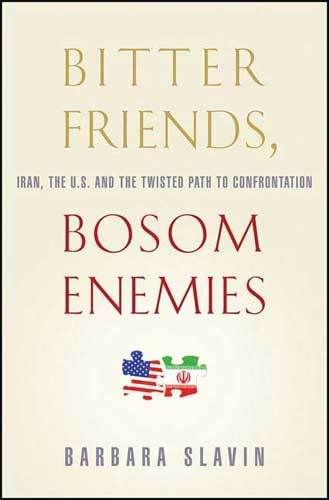
The topic below was originally posted on my blog, the Intrepid Liberal Journal as well as The Peace Tree, the Independent Bloggers Alliance and Worldwide Sawdust.
Barbara Slavin, senior diplomatic correspondent for USA Today since 1996 and author of the recently published book, Bitter Friends, Bosom Enemies: Iran, the U.S., and the Twisted Path to Confrontation (St. Martin’s Press), writes that,
“Iran and the United States are like a once happily married couple that has gone through a bitter divorce. Harsh words have been exchanged – husband and wife have come to blows and employed others to inflict more punishment. Apologizing is hard and changing behavior even harder. This relationship is unequal, with one side or the other feeling more vulnerable at any given time and afraid the other will take advantage of concessions.”
Currently, the public faces of both nations, presidents George W. Bush and Mahmoud Ahmadinejad, have been content to throw rhetorical bombs and raise the diplomatic temperature – increasing the likelihood of war. Indeed, at times it appears that conservative hardliners in both countries are eager for conflict as a means to maintain their respective grips on power.
The journey from the CIA backed coup that overthrew Iran’s democratically elected leader Mossadeq in 1953 and replaced him with the Shah, to the Islamic Revolution of 1979 and current tensions is replete with ill conceived schemes that damaged both nations. Slavin, using her extensive contacts among the powerful inside Iran and the United States, documents missed opportunities for reconciliation between both countries during the administrations of the first President Bush as well as Bill Clinton and George W. Bush.
The combination of her remarkable access to people such as Madeline Albright, Condelezza Rice, Iranian reformers like former President Mohammad Khatami, longtime establishment figures such as Ali Rafsanjani, as well as dissidents like Akbar Ganji and everyday citizens, allows Slavin to shed sunlight on a nation most Americans know very little about. She is also the first newspaper reporter from the United States to interview Iranian President Ahmadinejad.
Slavin has accompanied three secretaries of State on their official travels and reported from Iran, Libya, Israel, Egypt, North Korea, Russia, China, Saudi Arabia and Syria. She is also a regular commentator for U.S. foreign policy on National Public Radio, the Public Broadcasting System’s Washington Week In Review and C-Span. This month, she joined the U.S. Institute of Peace as a Jennings Randolph fellow, to continue her research on Iran. Slavin also serves as a member of the Council on Foreign Relations.
Prior to joining USA Today, Slavin was a Washington-based writer for The Economist and the Los Angeles Times, covering domestic and foreign policy issues, including the 1991-93 Middle East peace talks in Washington. From 1985-89, she was The Economist’s correspondent in Cairo. During her career, Slavin has traveled widely in the Middle East, covering the Iran-Iraq war, the 1986 U.S. bombing of Libya, the political evolution of the Palestine Liberation Organization and the resurgence of Islamic fundamentalism. Earlier in the 1980s, Slavin also served as The Economist’s correspondent in Beijing and reported from Japan and South Korea.
Prior to moving abroad, she worked as a writer and editor for The New York Times Week in Review section and a reporter and editor for United Press International in New York City.
Slavin agreed to a podcast interview with me about her book, Iran and their turbulent relationship with the United States. Our conversation is just under thirty minutes.
This interview can also be accessed via the Itunes Store by searching for “Intrepid Liberal Journal.” Another option is to access a media player at my blog.



.
Outside the local city supermarkt I was approached by an Iranian refugee with a showmap of color photo’s of abuse by the Iranian Islamic regime. Three of his brothers were executed by hanging for political opposition. His organization is trying to raise funds for lawyers to defend imprisoned Iranians in an effort to avoid executions.
I talked to him for a while and he was very sympathetic. His project was an advocacy for human rights in the region. I wanted to get an honest answer from him on issues of many opposition groups funded and supported by the US government to overthrow the regime by violent means. So I specifically asked him: “Should the US attack Iran for sake of democracy?” He answer was a resounding: “No! In case of war the people will suffer tremendously. His organization wants to strengthen Iranians to overthrow the regime from within.”
SFVI – Foundation of Family Members of Iran
≈ Cross-posted from my diary — Minot AFB 70 Airmen Demoted ≈
"But I will not let myself be reduced to silence."when talking to dissidents inside Iran about the prospect of military action from the U.S. I remember seeing Shrin Ebadi of Iran interviewed by Margaret Warner on PBS last year. Ebadi is an activist who has been imprisoned in Iran. Under the Shah she was a prestigious judge but with the Islamic regime under constant threat. She won the Nobel Peace Prize. Anyway, she expressed that military intervention by the U.S. would’ve been harmful. Hell, our bellicose diplomacy damaged the reform movement in Iran.
I think you would enjoy Slavin’s book.